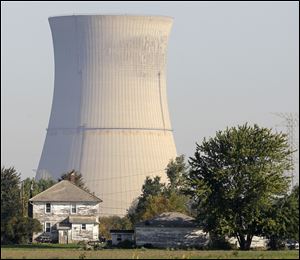
Davis-Besse to stay shut until probe ends
11/17/2011
The cooling tower of the Davis-Besse Nuclear Power Station looms over an adjacent farm.
OAK HARBOR, Ohio -- Crews are expected to pour concrete later this week to patch an access portal that was cut into the outer shield building at Davis-Besse nuclear plant to replace the plant's reactor head, a FirstEnergy spokesman said Wednesday.
But a Nuclear Regulatory Commission spokesman said the agency won't let the plant resume operation until the probe of hairline cracks found in the shield building's concrete after that hole was cut in October is complete.
"Until we have confidence that the cracks in the Shield Building don't have any safety implications, the plant won't go back online," Viktoria Mytling, spokesman at the NRC's regional office in Chicago, said.
She said a minor electrical fire that FirstEnergy Nuclear Operating Co. reported early Wednesday morning at the plant "is not a safety concern," but the federal agency expects FirstEnergy to investigate why a valve leak blamed for the fire occurred and will review the utility's findings.
NRC inspectors at the plant were "monitoring the situation as it happened," the spokesman said.
An alert was declared at Davis-Besse at 2:22 a.m. because of the fire, which affected an electrical panel in the plant's auxiliary building. The fire burned itself out within about 15 minutes, FirstEnergy spokesman Jennifer Young said. The alert was terminated at 4:43 a.m.
Water leaking from a valve on a pipe supplying water to offices in the building leaked onto the electrical panel, which supported a sump pump in the building, Ms. Young said. The water caused an electric arc that started the fire, she said.
The plant was shut down Oct. 1 for the reactor head replacement and thus was not operating when the fire occurred.
The reactor is contained and protected by separate 1 1/2-inch steel and 2-foot concrete structures through which a large hole was cut to provide external access for replacing the reactor head.
After the concrete was cut, workers discovered an "indication" of a 30-foot hairline crack, and subsequent tests revealed similar "indications" throughout the structure. FirstEnergy later said most such cracks were in decorative "architectural" concrete attached to the building's exterior to give it texture, but also disclosed that it was investigating several "indications" of cracks of a different nature in the concrete.
Ms. Young said Wednesday the reactor head replacement had been completed and that the steel removed to create the access hole had been welded back into place and pressure tested. The shield building hole should be patched by week's end, she said.
Ms. Mytling said such patching would not affect the NRC investigation, and no timetable is in place for restarting the plant.